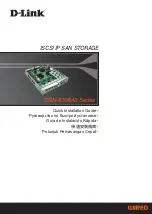DMA_TCDn_CSR field descriptions (continued)
Field
Description
This flag signals the channel is currently in execution. It is set when channel service begins, and is cleared
by the eDMA as the minor loop completes or when any error condition is detected.
5
MAJORELINK
Enable channel-to-channel linking on major loop complete
As the channel completes the major loop, this flag enables the linking to another channel, defined by
MAJORLINKCH. The link target channel initiates a channel service request via an internal mechanism that
sets the TCDn_CSR[START] bit of the specified channel.
NOTE: To support the dynamic linking coherency model, this field is forced to zero when written to while
the TCDn_CSR[DONE] bit is set.
0
The channel-to-channel linking is disabled.
1
The channel-to-channel linking is enabled.
4
ESG
Enable Scatter/Gather Processing
As the channel completes the major loop, this flag enables scatter/gather processing in the current
channel. If enabled, the eDMA engine uses DLASTSGA as a memory pointer to a 0-modulo-32 address
containing a 32-byte data structure loaded as the transfer control descriptor into the local memory.
NOTE: To support the dynamic scatter/gather coherency model, this field is forced to zero when written
to while the TCDn_CSR[DONE] bit is set.
0
The current channel’s TCD is normal format.
1
The current channel’s TCD specifies a scatter gather format. The DLASTSGA field provides a memory
pointer to the next TCD to be loaded into this channel after the major loop completes its execution.
3
DREQ
Disable Request
If this flag is set, the eDMA hardware automatically clears the corresponding ERQ bit when the current
major iteration count reaches zero.
0
The channel’s ERQ bit is not affected.
1
The channel’s ERQ bit is cleared when the major loop is complete.
2
INTHALF
Enable an interrupt when major counter is half complete.
If this flag is set, the channel generates an interrupt request by setting the appropriate bit in the INT
register when the current major iteration count reaches the halfway point. Specifically, the comparison
performed by the eDMA engine is (CITER == (BITER >> 1)). This halfway point interrupt request is
provided to support double-buffered, also known as ping-pong, schemes or other types of data movement
where the processor needs an early indication of the transfer’s progress.
NOTE: If BITER = 1, do not use INTHALF. Use INTMAJOR instead.
0
The half-point interrupt is disabled.
1
The half-point interrupt is enabled.
1
INTMAJOR
Enable an interrupt when major iteration count completes.
If this flag is set, the channel generates an interrupt request by setting the appropriate bit in the INT when
the current major iteration count reaches zero.
0
The end-of-major loop interrupt is disabled.
1
The end-of-major loop interrupt is enabled.
0
START
Channel Start
Table continues on the next page...
Chapter 22 Enhanced Direct Memory Access (eDMA)
K22F Sub-Family Reference Manual , Rev. 3, 7/2014
Freescale Semiconductor, Inc.
473


















